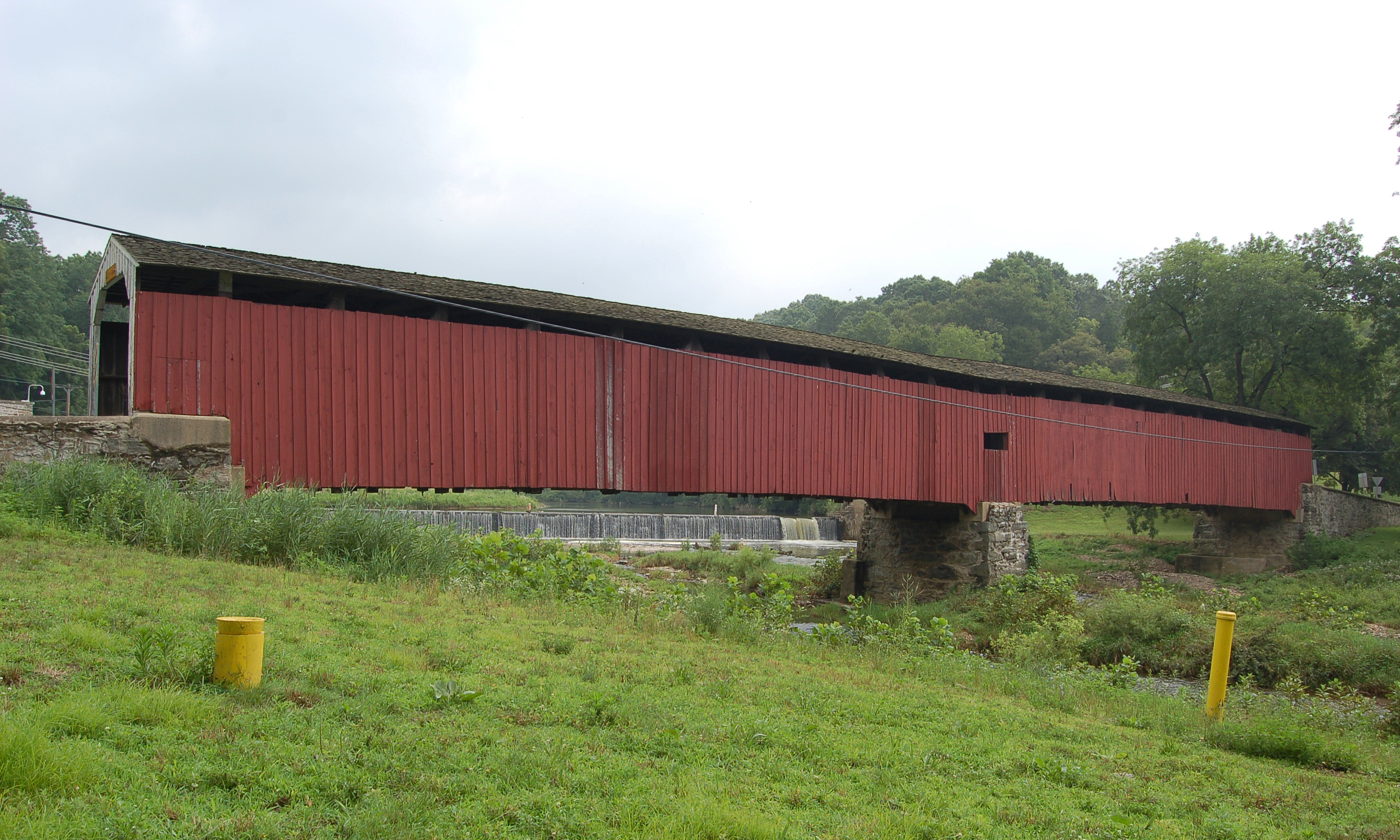Lancaster County, Warwick Township. Built 1843, rebuilt 1973. 180 ft long. Lancaster County's longest single-span covered bridge, open to traffic.

Pine Grove Covered Bridge
Lancaster/Chester County Line. Built 1864. 198 ft long. Lancaster County's longest covered bridge, Civil War era construction, open to traffic.
Lancaster County's longest covered bridge at 198 feet, stretching majestically across the rocky Octoraro Creek along the Lancaster-Chester county line. Built in 1864 during the height of the Civil War, this engineering marvel represents the pinnacle of Pennsylvania covered bridge construction, combining practical necessity with architectural ambition.
The bridge's strategic location served as a vital link between Lancaster's prosperous agricultural heartland and Chester County's mills and markets. Local bridge builders employed the proven Burr arch truss design, utilizing two separate spans supported by a massive central pier founded on bedrock in the creek.
The construction required thousands of board feet of old-growth timber, hand-hewn and fitted using traditional mortise-and-tenon joinery reinforced with oak treenails rather than metal fasteners. The bridge's name derives from the dense pine groves that once covered the surrounding hillsides, providing both timber for construction and a distinctive landmark for travelers.
CIVIL WAR HISTORY
During the Civil War, the bridge carried supply wagons supporting Pennsylvania's military contribution, with local farmers delivering grain, livestock, and provisions across the creek to collection points for Union forces. In the post-war years, the structure became a gathering place for the community, with annual picnics held along the creek banks and swimmers enjoying the deep pools beneath the bridge during hot summer months.
MODERN ADAPTATIONS
The early 20th century brought increasing traffic loads as automobiles replaced horse-drawn vehicles, necessitating reinforcement with steel beams and cables in the 1930s. Despite these modifications, the bridge retained its essential 19th-century character.
Major restoration in 1988 addressed deteriorating timbers and strengthened the foundation (cost: $175,000), while a comprehensive rehabilitation in 2008 replaced the deck and siding while preserving original structural members (cost: $420,000).
INTER-COUNTY COOPERATION
The bridge's location on the Lancaster-Chester county line created unique administrative arrangements for maintenance and preservation. Both counties share responsibility for the structure, with Lancaster County typically handling the bridge itself while Chester County maintains the approaches on its side. This cooperative arrangement has generally worked well, demonstrating successful inter-county heritage preservation cooperation.
VISITING INFORMATION
Open year-round to vehicle traffic with an 8-ton weight limit. Popular photography and fishing location. Parking available at both county approaches. Frequently visited by Amish buggies. Creek access points for fishing enthusiasts. No admission fee. Interpretive signage explains dual-county significance.
Photography: Outstanding subject with double-span composition. Best light early morning from eastern approach. Autumn foliage reflects dramatically in creek. Position downstream to capture both spans. Spring runoff creates dramatic water flow. Winter snow enhances architectural details.
NEARBY ATTRACTIONS
Historic Oxford downtown (5 miles) Nottingham County Park (3 miles) Chester County wineries within 10 miles White Clay Creek State Park (12 miles) Lincoln University (8 miles)
The surrounding landscape retains much of its rural character, with working farms visible from both approaches and the creek providing habitat for native trout and waterfowl.
Similar Bridges in category
Lancaster County, Leacock/Paradisehttps://directify.app/app/2294/projects/10553608/edit Townships. Built 1844. 178 ft long. One of 12 double-span, double-arch covered bridges in USA, pedestrian access only.
Built in 1860, this 122-foot Burr Truss bridge spans Pequea Creek in Lancaster County, one of Pennsylvania's most scenic covered bridges.


